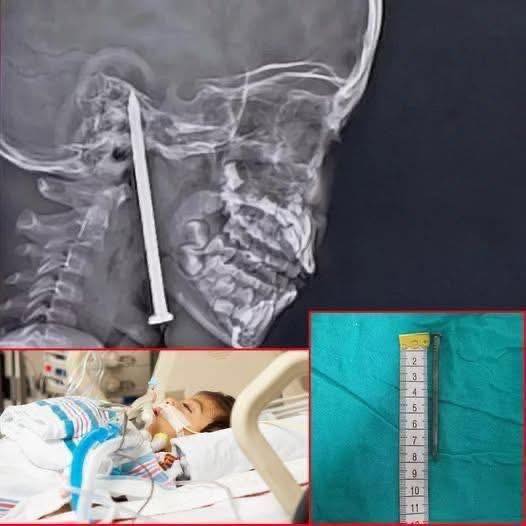In the lively town of Balrampur, what began as an ordinary day quickly spiraled into a nightmare that no family could ever be prepared for. A sunny afternoon on the playground—filled with children’s laughter, running footsteps, and carefree games—turned into a scene of horror when a freak accident left a seven-year-old boy fighting for his life.
It all started so innocently. The boy was climbing on a wooden structure with his friends, chasing the kind of joy only children understand. But in a single misstep, joy turned to tragedy. He slipped, and in an instant his small body struck a part of the play equipment that had been left dangerously unmaintained. A three-inch nail, rusty and protruding from the wood, pierced straight into his neck. The impact was devastating—the sharp metal cut deep, burrowing its way up toward his head, extending dangerously into his brain.
The playground, once filled with playful shouts, erupted into screams. Adults rushed toward the child, their hands trembling as they tried to help, but the sight was too horrifying to disguise. Blood streaked down his small frame, his wide eyes glazed with shock. And yet—against all odds—he remained conscious. His friends stood frozen, unable to grasp what they were witnessing, while his parents, who had been nearby, sprinted toward him in terror.
With no time to lose, the boy’s parents rushed him to King George’s Medical University (KGMU), one of the region’s most advanced trauma centers. There, a team of specialists immediately ordered scans to assess the extent of the damage. The results were nothing short of astounding. The nail had pierced deep into his skull, its tip pressing dangerously close to a major blood vessel. A fraction of a millimeter’s difference, doctors explained, could have led to catastrophic bleeding or instant death.
The stakes were clear: a miracle was needed, and it would have to be performed in the operating room. Within minutes, a multidisciplinary team—neurosurgeons, ENT experts, anesthesiologists, and trauma specialists—assembled to attempt one of the most delicate surgeries imaginable. The task was as terrifying as it was urgent: removing the embedded nail without damaging critical brain tissue or triggering massive bleeding. Every movement of their hands would determine whether the child lived or died.
For four grueling hours, the surgical theater became a battleground between life and death. The atmosphere was tense, yet filled with absolute concentration. Surgeons worked millimeter by millimeter, carefully dislodging the nail while navigating around vital arteries and brain structures. Outside the theater, the boy’s family waited in anguish, clinging to prayers, every passing second feeling like an eternity.
At last, the doors opened. The exhausted surgical team emerged, their faces weary but triumphant. They had done the impossible—the nail was removed without damaging any critical structures of the brain. The child had survived. The parents, overwhelmed with relief, wept openly, falling to their knees in gratitude. They clutched the hands of the doctors, calling them angels sent by God.
The boy was then moved to the Pediatric Intensive Care Unit (PICU), where every heartbeat, every breath was carefully monitored. Doctors braced themselves for complications—infection, swelling, neurological damage—but to their amazement, recovery began swiftly. Within days, the swelling reduced, his vitals stabilized, and he began to respond to his parents’ voices. His first words after surgery brought tears to his mother’s eyes: a fragile but undeniable proof that his mind had survived intact.
This case quickly became a landmark in pediatric neurosurgery. The KGMU team described it as one of the most extraordinary they had ever encountered, emphasizing the razor-thin margin between life and death. They began preparing a detailed medical report to publish internationally, believing it would serve as a milestone for emergency pediatric care and an invaluable lesson for medical professionals worldwide.
For the family, however, no publication could capture the rollercoaster of despair, fear, and overwhelming gratitude they had lived through. “We thought we had lost him,” the father whispered, holding his son’s tiny hand. “But God gave him back to us through these doctors.” His mother added softly, “Every time I see him smile, I know we’ve witnessed a miracle.”
The incident also sparked wider debate in the community. Parents, teachers, and local leaders demanded stricter safety standards for playgrounds. Nails, sharp edges, and broken structures, they argued, had no place in spaces meant for children’s joy. “This survival is a miracle,” one local teacher remarked, “but miracles cannot be our safety net. We must create safe environments so that no child has to endure such suffering.”
Doctors echoed this sentiment. They stressed that while this case ended with success, the outcome could easily have been tragic. Prevention, they reminded the public, is always better than relying on surgical miracles.
Today, the boy continues to recover, his strength returning day by day. Physiotherapy will help him rebuild coordination, but specialists are optimistic that he will live a full, normal life. Neighbors now call him “the miracle child,” and his story has spread far beyond Balrampur, inspiring strangers across social media who send prayers and messages of admiration.
The rusty nail that nearly ended his life now rests in the hospital archives—a grim reminder of how close the world came to losing him. But the true legacy lies in the resilience of a child, the skill of a medical team, and the faith of a family that refused to give up.
In the end, this is not just the story of an accident. It is a story of hope, survival, and the extraordinary strength of the human spirit.
